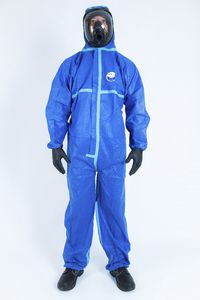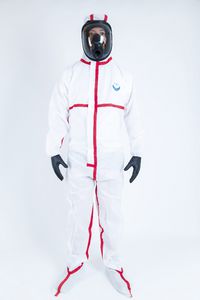
- Products
- Catalogs
- News & Trends
- Exhibitions
Chemical protection coveralls WEEJET work3/4/5/6 typepolyethylene



Add to favorites
Compare this product
Characteristics
- Type
- work
- Type of protection
- chemical protection, 3/4/5/6 type
- Material
- polyethylene
- Applications
- for the chemical industry
- Sex
- unisex
Description
Chemical protective coverall.
APPLICATIONS
– Petrochemical industries
– Industrial and tank cleaning
– Epidemic and viruses
– Remediation of polluted water
– Remediation of polluted sites
– Chemical industries
– Emergency services
– Offshore Maintenance
– Nuclear industry
PROTECTION STANDARDS
Type 4 : EN ISO 14605 : Protection against saturation liquid of chemicals
Type 5 : EN ISO 13982-1 : Protection against hazardous dry particulates
Type 6 : EN ISO 13034 : Protection against light spray of liquids
EN ISO 1073-2 : Protection against radioactive particulates contamination
EN ISO 14126 : Protection against infectious agents
EN ISO 1149-5 : Antistatic garment requirements
SIZES: M to XXL
FEATURES AND BENEFITS :
Weejet coverall type 3 provides a suitable protection against abroad range of chemical hazardous protection. Effective protection against range of commonly used chemicals combined with taped seams, double zip & storm flap. In addition, WeeJet garment feature a finger loop and knitted cuff to enhance comfort, durability and safety.
BONUS ADD-ON :
Garment combines resistance pressured jet and freedom-of-movement thanks to its special design: double zip/storm flap and knitted cuff/thumb loop.
Protective coverall, Body protection, personal protection equipment, single use suit, personal safety gear, PPE, polyethylene, comfort, composites, paint, automobile, stick, solvent, agri-food, high permeability,EN 14605 , EN 13982-1, EN 13034, EN 1073-2, EN 1149-5
VIDEO
Catalogs
Related Searches
- Fabric clothing
- Waterproof clothing
- Chemical protection clothing
- Work coveralls
- Unisex coveralls
- Clothing with hood
- Construction clothing
- Anti-static clothing
- Fabric coveralls
- Chemical protection coveralls
- Zippered coveralls
- Clothing for the food industry
- Coveralls with hood
- Medical clothing
- Electrical protection coveralls
- Disposable coveralls
- White coveralls
- Anti-static coveralls
- Blue coveralls
- Waterproof coveralls
*Prices are pre-tax. They exclude delivery charges and customs duties and do not include additional charges for installation or activation options. Prices are indicative only and may vary by country, with changes to the cost of raw materials and exchange rates.
















